What China Offers Students
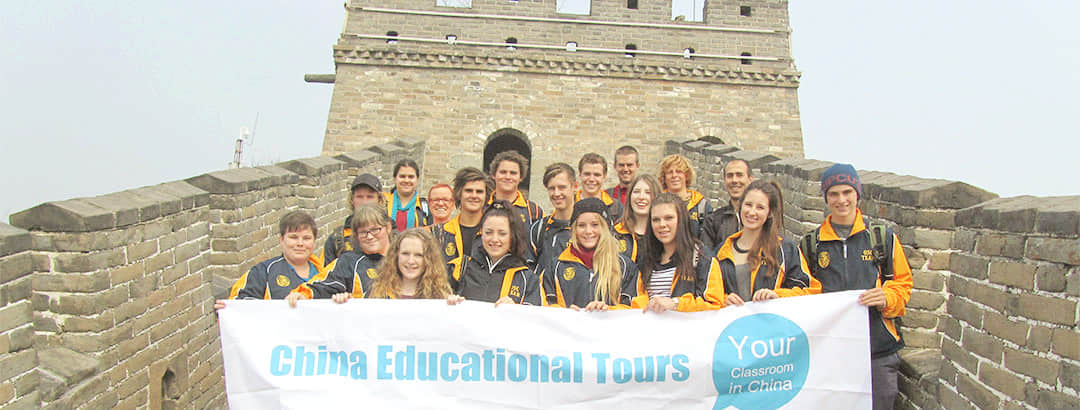
Why You Should Take Your Students Overseas
 Download the PDF
Download the PDFHaving a diverse, international perspective with international experience has become ever more important over the last two decades. Stats show that students, and people, who have international experience get better jobs with higher salaries (UC Merced1). Plus, with technology making communication and information easily available and affordable, traveling overseas is fun and rewarding, safe, and you can keep up with friends and family while away. In fact, with the ability to upload pictures instantly and video chat with anyone for free, one can now travel overseas while virtually taking their family and friends along!
Why Choose China? Why Visit China
Once you’ve made the great decision to travel overseas, you then have to pick your destination. Many countries can offer a variety of enriching experiences, but few can offer the cultural, natural, and modernly relevant variety that China offers. China is one of only four countries/regions in the world that can trace their history back 5,000 years (Egypt, Mesopotamia, and India being the other three). In fact, some artifacts on display in Chinese museums do in fact date back 5,000 years, such as the recently discovered Zhuangqiao relics 2 that show some of the earliest found human writing ever discovered or the Xianrendong cave 3 pottery discoveries which have been confirmed to be the oldest known pottery in the world dating back a very impressive 20,000 years.
More famous, yet somewhat “young” in comparison, are the great wall (some sections about 2,300 years old) and the Terracotta Warriors (a little more than 2,000 years old). Both Chinese Opera and Shadow Puppets trace their origins back around 2,000 years ago. The list can go on for some length.
China offers more than windows into an ancient culture. China’s natural features are some of the very best in the world. From the uniquely crystal clear turquoise and violet colored mountain ponds in the Jiuzhaigou national park to the jaw-dropping cliffs that plummet to the powerful Yangtze River; from the awe-inspiring heights of the snowcapped Himalayan mountains in the Tibetan region to the seemingly crayon-colored stripped rock formations in the desert of Danxia; from golden sunsets over the sandy dunes of the Gobi desert to some of the most postcard worthy mountain lakes draped with more snow capped mountains in Xinjiang; and from the other-worldly, multi-peaked rocky hills which outline multiple lazy rivers inhabited by the Currant’s (fishing birds) homeland of Guilin to the mesmerizing repeating patterns of the Yunnan rice terraces; China offers top quality natural wonders that are among the most awe-inspiring on the planet.
As if the above weren’t enough reasons for an extra-long visit, it’s no secret that China’s position in the world has become elevated to one of the most important, and influential. Knowledge of Mandarin and Chinese culture can be a huge advantage in today’s, and tomorrow’s, business environment. A trip to China can not only be one of the most memorable experiences of one’s life, but also may lead to an invaluable advantage over the course of one’s career. Read further for more details on some of the best that China has to offer and why China should be anyone’s #1 choice for an overseas experience.
What China offers your students?
Ancient History

The Great Wall
Did you know that there is not one Great Wall, but actually several different ones? Only parts of the original wall survive today, and contrary to popular belief the entire surviving wall is not completely connected. China’s Great Wall is a collection of several great walls built by different dynasty’s over the course of around 2000 years. While Beijing is one of the most popular spots to see the Great Wall, the desert backdrop around Jiayuguan’s Great Wall section makes for another unforgettable trip.
The Forbidden City
Ranking up there with the Eiffel Tower, Big Ben, and the Leaning Tower of Pisa as iconic images famous the world over, a picture in front of here will long be one of the best pictures you will ever take and is ‘the’ iconic image that says “China” to many people in the world. Step inside and feel like you are immediately 100’s of years back in time. Expansive and immaculately preserved, take your time inside as if you were sipping hot tea.
The Potala Palace
So graciously and gently sprawled along a hill 12,100 feet in altitude (3,700m) with snow capped Himalayan mountains in the background, there is simply nothing like it on earth. The Greek Gods themselves would have been jealous to have such a majestic structure built in their honor, closer to the clouds than any other palace in the world. Even today where international travel is as common as a local beach trip in the 1960’s, few people have ever made it here – but for those who have, the journey, and the surrounding Tibetan area, are even more rewarding than setting your very own eyes upon this Buddhist stoned majesty.
The Terra Cotta Warriors
Stunningly life-like and each uniquely different, it’s not only fun to point of the subtle differences in each statue’s face, but also simply jaw dropping to see thousands of these warriors standing side-by-side in their enormous excavation room. Visiting this army takes you to not just a museum, but to the actual excavation site where workers still diligently exhume more artifacts every day. Standing inside a building bigger than five airplane hangers together, this is an army unlike anything found today, anywhere.
Mogao Caves
Be careful if you Google this site as many images may pop up tagged as being part of Mogao caves, but are actually part of other locations, like the also-popular Longman Grottoes. Mogao is one of the premier Buddhist cave art examples in the world. Experts from all over have come, and still visit, Mogao to study these incredibly well-preserved cave paintings done over 2,000 years ago by Buddhist monks. Honestly, inside even smells 2,000 years old and the artwork is exquisite… and breathtaking.
Chinese Culture
China is big. China is old. China has a large population. Combine these three and you get a rich variety of unique cultural traditions, religious philosophies, and artforms.
Confucianism, Taoism, and Legalism
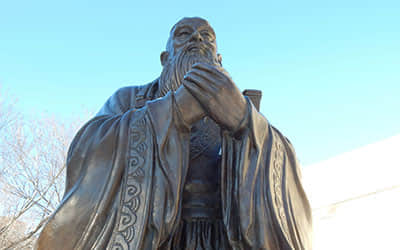 Confucianism
Confucianism
Philosophical thought has long been a staple of ancient Chinese culture. While visiting China, you’ll have ample opportunities to learn about, experience, participate in, and practice many forms of Chinese philosophy. The following three are part of the four most influential schools of Chinese thought, referred to as the “Contention of a Hundred Schools of Thought”.
Confucianism – Sometimes called a “civil” or “diffused” religion, Confucianism is based on the teachings of the famous ancient Chinese philosopher Confucius from around 500BC. While too complex to give a good, brief explanation, it basically stresses the importance of family and societal harmony through following the principles of duty, obedience, and hierarchy. Confucianism does not worship any gods or have any rituals.
Taoism – Different in many ways from Confucianism, although these differences can often be difficult to fully understand from a western point of view, Taoism stresses the importance of freedom, equality, natural living, and mysticism and incorporates ritual practices and the worship of various gods (which are usually on display either in statue or painting form in Taoist temples).
Legalism – A philosophy which basically states that humans are more inclined to do wrong than right because they are entirely motivated by self-interest. In order to prevent this wrong, a ruler needs to create a body of laws which would motivate people (through strong punishments, and therefore self-interest) to do right by society instead of wrong.
56 ethnic groups
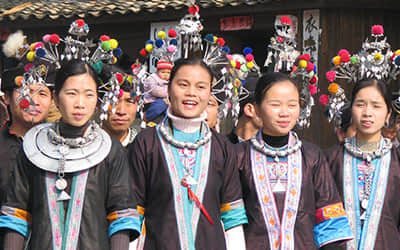 Zhuang People
Zhuang People
Most people, when they think of “China”, think only of the majority Han culture. Han Chinese account for over 90% of all Chinese citizens so it’s true that they, and their culture, make up the vast majority of the country. However, there are 55 other recognized ethnic groups in China. Each group has their own rituals, religious beliefs, language, culture, clothing, food, traditions and history. Most of these ethnic minorities will be found in the very southern part, the very northern part, and all of the West beginning at the base of the Himalayans. Some of the larger groups are Zhuang, Hui, Manchu, Uyghur, Yi, Tibetan, Mongol, Dong, Yao, Bai and Kazkh. A visit to a town, city, or rural area where these groups live can be a beautifully memorable experience. Visitors will often see unique: colorful clothing; food and beverages; home designs; jewelry and artwork; and religious buildings and objects.
Chinese Art forms – Calligraphy, Painting, Opera, Shadow Puppets
Harmonious, gentle, fluid, rich, smooth, colorful … all perfect ways to describe the many different Chinese art forms. While traveling in China, it is easy to see, or do, many of these. Opera and Shadow puppet shows are common in every major city. Chinese paintings adorn many nice restaurants, hotels, and homes, and of course for the serious art buff, be sure to enjoy China’s many art museums. Calligraphy can be easily purchased, or you can easily take a class where you’ll end up making your very own masterpiece.
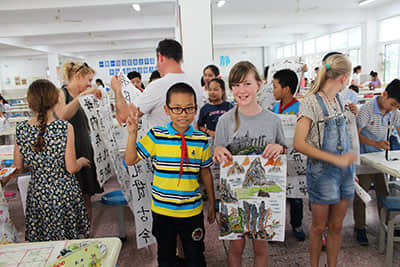 Painting Class
Painting Class
Calligraphy – Grab a big wooden brush, dip it in ink, and let your teacher guide you as your hand gently ebbs back and forth crisscrossing lines that may not make sense to non-mandarin speakers, but will nonetheless, speak volumes.
Chinese Painting – Recognized by popular themes of landscapes (often of the jaw-droppingly gorgeous rocky peaks of the Li River Valley), tree branches, rivers, bridges, quiet towns, waterfalls, cloudy peaks – or other subjects that radiate a sense of peace and harmony.
Chinese Opera – There are many different branches, or types, of opera, but they could be simplistically divided into Northern and Southern. Similar to Western opera in that the show tells a story, it would be different in every other way. Performers wear elaborate, colorful costumes resembling ancient Chinese dress, heavy make-up, and uber elaborate headdresses and masks. The most notable feature of the opera is the long drawn-out arias that can reach and sustain very high pitched notes. The Chinese opera is an experience (love it or hate it) that you’ll never forget.
Shadow Puppets – For children and adults alike, one of the more whimsical Chinese art forms are the two-dimensional puppets-on-sticks that are held behind a white screen and backlit so their shadow is cast onto the screen. Unseen actors move the sticks, provide dialogue (almost always in Mandarin) and musical accompaniment, while telling their story. Performances are often funny, usually easy to find in any city, and sometimes can be as short as 20 minutes.
Chinese Kungfu, Qigong, Taichi
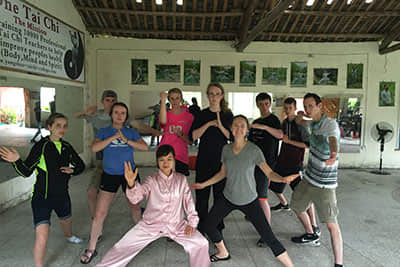 Taichi Class
Taichi Class
Chinese marital arts, including non-violent body movements, focus on a person’s ability to channel positive energy and maintain a concentrated focus. Kungfu has of course been popularized in Hollywood movies (sometimes unfairly characterized as a violent form of attack) and Taichi (with its cousin Qigong) have become quite popular in Western gyms and homes. Whether you’d like some light exercise or an intense workout teaching you self-defense skills, it’s easy to do both while in China.
Kungfu is not one fighting style, but hundreds and they differ by region and internal verses external focuses. Beginner to advanced courses can be found in China and a beginner course in the discipline can be life-changing for many people. It’s not necessary to want to be a black belt as many people get increased self-esteem, practical self-defense tactics, and invaluable training on how to focus their internal energy from just a few basic classes.
Taichi and Qigong are not fighting forms, but instead more of a slow, fluid, personal dance that use some martial art movements. While not exactly the same, they are both similar body movements that use the body’s natural energy (called Qi) and are relaxing yet great exercise. If you want to try either while in China, you’re in luck. They’re one of the easiest, and cheapest, activities to participate in. Any given morning or evening, but especially Friday and Saturday night or Saturday and Sunday morning, groups of people numbering 20 to 200 will congregate in public parks and follow a leader (who brings the music) for a 30-60 minute session. Anyone is welcome and usually these sessions are free – although in some rare cases sessions may need to be paid for so just look around after everyone finishes to see if people are digging out money.
Chinese Cuisine
It’s pretty much impossible to write a comprehensive list of Chinese cuisine here with so much flavor variety found in such a large country, so we’re just going to list a few of the best. But first, a few general notes:
- 1) Westerns may be surprised to find that the food in China will differ significantly from the Chinese food found in western countries, where it has been adapted to local preferences. So, don’t expect to find your favorite local Chinese restaurant’s dish here.
- 2) In general, noodles are slightly more popular in the North, rice in the South, and bread-like dishes in the West.
- 3) The cuisine of the southern province of Guangdong (known as Canton outside of China and including Hong Kong) has unique flavors and style of cooking. Likewise, Central and Western China have their own unique flavors. For some people, the North has food that people typically associate with “Chinese food”.
- 4) There is truly no need for travelers to patron any western fast food restaurant while in China (even for people who aren’t naturally fans of Chinese food – re-read #1). In fact, not trying the food is like checking into a 5-star hotel and never sleeping in the bed. The food infuses a trip with personality and China would win an Academy award on its cuisine’s personality alone. Following a guide’s suggestions or doing a little online research can ensure that you always eat in completely safe, and truly knock-your-socks-off establishments. Don’t shy away from the street food either – quick, cheap, and sometimes even more delicious than big restaurants, you may have you best meal standing beside a street vendor. Just use the rule that if there’s a lot of people eating there, it’s probably a safe bet. Keep an open mind, a sense of adventure for flavor, and you may find yourself wanting to return to China just to keep eating!
Pulled Noodles – Tip #1: if you ever pass by a window and see someone hand-pulling dough into thin noodles, RUN inside and order. This author is partial to the cumin lamb dish.
Dimsum / Jiaozi (Chinese Dumpling) – Dimsum is a category of dumplings, of which, Jiaozi is one specific type. Usually served steamed, making the outer dough layer very moist, dumplings are often served with a dipping sauce and each dumpling is stuffed with a variety of scrumptious mixes – such as pork, shrimp, beef, chives, cabbage, or tofu.
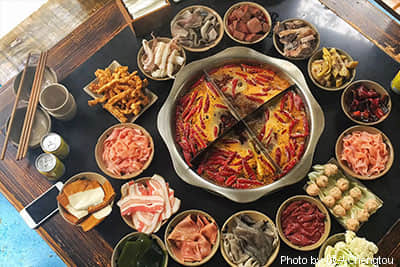 Hot Pot in Sichuan
Hot Pot in Sichuan
Flat bread / Chive pancake – Big, flat, round, and crisped perfectly, this pancake-like bread dish is usually cut like a pizza, sold at street vendors everywhere, fast, cheap, and you may not be able to stop eating it. Perfect food for when you don’t have a lot of time.
Peking Duck – You might have tried this dish before, but if you haven’t had it in China, it’s possible that you haven’t really had it. An absolute “must-try” during any trip to China, a good restaurant will serve it crispy on the outside, juicy on the inside, and mouth-wateringly orange everywhere.
Hot Pot – Perfect for when it’s cold out, this is one of the more unique style of dishes served in China. A communal type dish that is based around a hot pot of broth placed in the center of the table with bowls of fresh beef and vegetables placed around it. The broth cooks the thinly sliced beef within seconds and makes for a fun, juicy, flavorful good meal. It’ll be extra spicy if of the Sichuan variety (here “hot” = “spicy”), but regular hot pots are not necessarily spicy (here “hot” = “temperature”).
General Tso’s Chicken, Sweet and Sour Pork, & Spring Rolls – Yes, you can get these in China, and they’ll probably taste better than back home.
Mapo Tofu – Mapo Tofu, a typical Sichuan cuisine, mainly made of soft tofu, spicy chili, flower pepper, oily sauce and often topped with minced meat. This dish has a great unique flavor of “mala” in Chinese. The pungent taste is a combination of numbing and spicy, the numbness comes from flower pepper, referring to the feeling that like touching the terminals of a nine-volt battery to your mouth and tongue. If you want to challenge your taste buds, to try this authentic flavor is a great choice.
Natural Landscape

China alone has as any many natural wonders as the USA, Canada, or Europe – yet are uniquely Asian. Imagine a country that has parks equal in beauty to the Canadian Rockies, Yellowstone, Yosemite, the Alps, the Black Forest, Pyrenes, combined with majestic Sahara-like sand dunes and memorizing rich green rice terraces. Nearly every temperate climate on the planet can be found within China’s borders, and the best destinations are unlike anything you’ll find anywhere else. If you like our condensed list below, keep checking and you’ll discover dozens more bucket-list destinations.
Zhangjiajie National Forest Park
Many people don’t know that the thousands of chimney-like peaks are the inspiration behind the mega-famous floating mountains of Pandora in the movie Avatar. While the real-life Chinese Pandora peaks don’t float (of course), the misty clouds that often fill in the gaps around their base give the impression that the tops are mind-bendingly suspended in mid-air.
Huangshan (Yellow) Mountain
For fans of high mountains that inspired scenes in famous movies, this mountain range in the very center of China should be top on your list. Huangshan (along with the Li River valley mentioned below) formed the Valley of Peace in Kungfu Panda. Unlike other mountain ranges, Huangshan has sheer cliffs that drop thousands of feet straight down into nothingness – and for those who like a little adventure, narrow wooden walkways cling perilously to the side. A cable car takes people to the top where multiple fenced overlooks give unprecedented views of the surrounding area. Like at Zhangjiajie, misty clouds abound.
Li River
Looking like a mythical dragon’s undulating back sticking out of water, the thousands of rocky formations in the Li River Valley are simply stunning. This area forms the end of a long journey for rivers starting in the Himalayans. By the time the water reaches the valley, it finds itself in a flat basin (under 500 feet in elevation) allowing it to meander peacefully, almost sleepily, back and forth all the way to the ocean. The curvy, expansive rock formation make for spectacular sunsets and floating down the river on a bamboo raft makes travelers wonder if they’re still on this planet.
Namtso
The crystal-clear water here perfectly reflects the deep blue, crystal-clear skies in this Himalayan lake in Tibet. Skies in the Himalayans are usually some of the deepest blue skies one can find due to arid conditions and the altitude itself. At nearly 15,000 feet (4,400m), there’s just not much left between visitors and all that jaw-dropping blueness. As an added bonus, the lake is ringed with snow capped mountains which gives an unforgettable contrast between the deep blue sky above, the pure white snow, the sandy yellow ground, and the deep blue lake.
Danxia Rock
Once here, you may think these rock formations can’t be real – “certainly, someone must have painted them!” you might exclaim. Yet, these crayon colored red, yellow, white, and blue banded rocks look straight out of a science fiction film. Tip: if the rocks are wet, and it’s sunny out, the colors are significantly amplified.
Festivals

China has more festivals than the ones we list here, but the following are often the most popular with tourists.
Chinese New Year
Held in January or February (depending on the Lunar Calendar), this is one of the most vibrant festivals anywhere. Chinese New Year can best be explained to Westerns as combining the familia importance of Christmas with the celebratory atmosphere of New Year’s Eve – and it goes on for 10 days! Chinese lanterns gently glow dimmer and dimmer as they effortlessly float off into the night sky; Human-sized puppet Dragons and Lions dance and pull acrobatic moves surely to impress any ‘Talent’ judge; fireworks sizzle and pop every night from all over every city and town; traditional red Chinese decorations illuminate every street, lamp post, bridge, and building; and then there’s food.
Dragon Boat Festival
Held in May or June (depending on the Lunar Calendar), this is famous for its long wooden boats carved to look like, well … a dragon. Dozens of men and women paddle one boat while a drummer at the head pounds out the team’s rowing rhythm. With dozens of these boats racing side by side and hundreds of ores splashing at the same time, it’s a race worth to catch.
Mid-Autumn Festival
Held in September or October (depending on the Lunar Calendar), this is famous for a super full, extra bright moon, and a sweet treat aptly named “Moon Cakes”. Mid-Autumn offers a nice reprieve from the summer heat when many families will watch the moon rise and eat moon cakes. In southern parts of China, there may also be New Year-like dragon and lion street dances.
What CET Can Offer
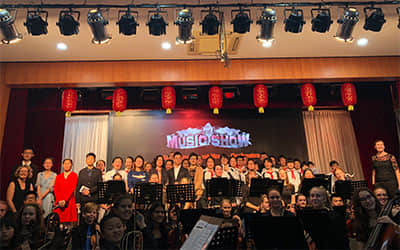 Music communication with local school
Music communication with local school
Click here for a full list of programs we offer. For a brief list related to the information discussed in this article, please see below.
In-depth culture activities
CET prides ourselves on not being just a travel agency, but an educational tour company providing more than fun vacations. We can offer experiences difficult to find through other travel companies.
Learn Mandarin
We have tours that offer Chinese language classes. Learning a base in Mandarin can help facilitate further study once back in a traveler’s home country. Adding “Mandarin” to a resume, or college application, is perhaps one of the most impressive, attention-grabbing skills today.
Short-term exchange program with Chinese schools
Language knowledge is great, but a truly well-rounded experience is made through in-depth cultural connections. We offer short-term exchange programs with Chinese schools that give rich, rewarding, and possibly life-changing experiences to students. Besides, speaking some Mandarin and showing that one has completed an exchange program in China are envious experiences for college or job candidates.
 A friendly game of football with local school
A friendly game of football with local school
Be Shanghainese for a day
Instead of merely walking around Shanghai taking pictures, why not stay with a family for the day and live as they live? Taking it slow and seeing true life in China’s largest city makes a stronger, longer-lasting connection than the typical trips which only show a city’s touristy highlights.
Community service
In addition to seeing famous places in the country, why not make a contribution and learn valuable skills in the process? CET offers many one or two-day volunteer programs that allow participants to get to know locals better and help local communities in meaningful ways.
Clean a section of the Great Wall
Just being at the great wall is amazing, but leaving knowing that you helped preserve it? We’d like to think that makes for a great story when you get home – besides learning valuable lessons about preservation and history.
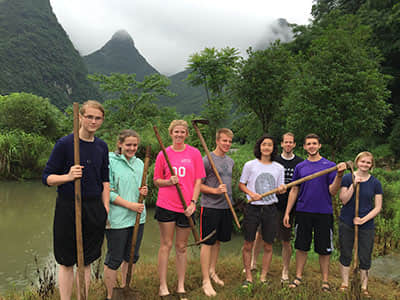 Community Service in Yangshuo
Community Service in Yangshuo
Volunteer in an orphanage
While people can volunteer at local orphanages back home, there’s a special feeling from helping children in another country and from another culture.
Be a Panda Keeper
Don’t just look at the world famous Giant Panda from afar, get up close. CET helps those interested in volunteering to care for a panda for one day and as an added bonus, you’ll get closer to these gentle giants than anyone you know.
Company visit
Have any business majors or future business minds in your group? China is now one of the top countries in the world to do business and learning how business is done can give someone a major advantage in their career or educational aspirations. We offer visits to Chinese companies where students can get a first-hand look at business practices, make contacts, and maybe even learn some Mandarin.

 Why Choose Tailor-Made China Tours for Schools
Why Choose Tailor-Made China Tours for Schools 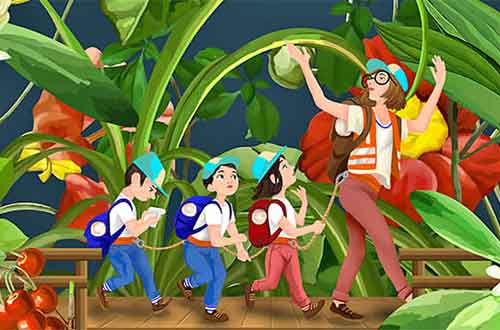 Teacher Zone: Steps to Planning a School Trip to China
Teacher Zone: Steps to Planning a School Trip to China 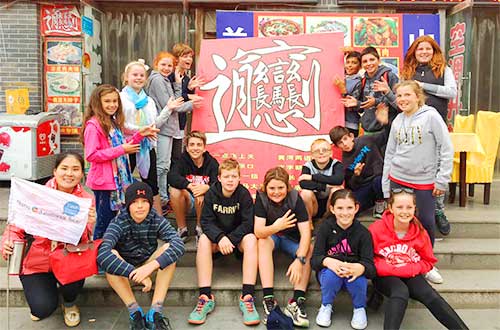 Top 7 Ideas for a School Trip to China
Top 7 Ideas for a School Trip to China 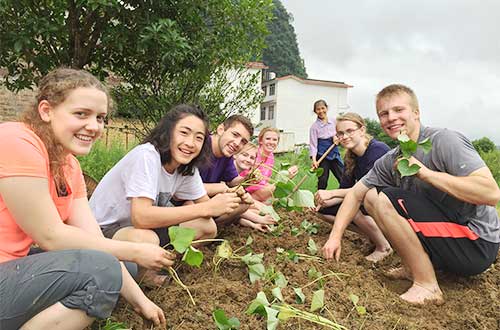 The Top Activities for School Trips to China: Primary, Middle & High School, University & College
The Top Activities for School Trips to China: Primary, Middle & High School, University & College